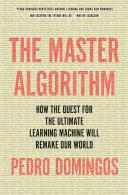Книга: The Master Algorithm: How the Quest for the Ultimate Learning Machine Will Remake Our World
Chapter Eight
Chapter Eight
The Scientist in the Crib, by Alison Gopnik, Andy Meltzoff, and Pat Kuhl (Harper, 1999), summarizes psychologists’ discoveries about how babies and young children learn.
The k-means algorithm was originally proposed by Stuart Lloyd at Bell Labs in 1957, in a technical report entitled “Least squares quantization in PCM”* (which later appeared as a paper in the IEEE Transactions on Information Theory in 1982). The original paper on the EM algorithm is “Maximum likelihood from incomplete data via the EM algorithm,”* by Arthur Dempster, Nan Laird, and Donald Rubin (Journal of the Royal Statistical Society B, 1977). Hierarchical clustering and other methods are described in Finding Groups in Data: An Introduction to Cluster Analysis,* by Leonard Kaufman and Peter Rousseeuw (Wiley, 1990).
Principal-component analysis is one of the oldest techniques in machine learning and statistics, having been first proposed by Karl Pearson in 1901 in the paper “On lines and planes of closest fit to systems of points in space”* (Philosophical Magazine). The type of dimensionality reduction used to grade SAT essays was introduced by Scott Deerwester et al. in the paper “Indexing by latent semantic analysis”* (Journal of the American Society for Information Science, 1990). Yehuda Koren, Robert Bell, and Chris Volinsky explain how Netflix-style collaborative filtering works in “Matrix factorization techniques for recommender systems”* (IEEE Computer, 2009). The Isomap algorithm was introduced in “A global geometric framework for nonlinear dimensionality reduction,”* by Josh Tenenbaum, Vin de Silva, and John Langford (Science, 2000).
Reinforcement Learning: An Introduction,* by Rich Sutton and Andy Barto (MIT Press, 1998), is the standard textbook on the subject. Universal Artificial Intelligence,* by Marcus Hutter (Springer, 2005), is an attempt at a general theory of reinforcement learning. Arthur Samuel’s pioneering research on learning to play checkers is described in his paper “Some studies in machine learning using the game of checkers”* (IBM Journal of Research and Development, 1959). This paper also marks one of the earliest appearances in print of the term machine learning. Chris Watkins’s formulation of the reinforcement learning problem appeared in his PhD thesis Learning from Delayed Rewards* (Cambridge University, 1989). DeepMind’s reinforcement learner for video games is described in “Human-level control through deep reinforcement learning,”* by Volodymyr Mnih et al. (Nature, 2015).
Paul Rosenbloom retells the development of chunking in “A cognitive odyssey: From the power law of practice to a general learning mechanism and beyond” (Tutorials in Quantitative Methods for Psychology, 2006). A/B testing and other online experimentation techniques are explained in “Practical guide to controlled experiments on the Web: Listen to your customers not to the HiPPO,”* by Ron Kohavi, Randal Henne, and Dan Sommerfield (Proceedings of the Thirteenth International Conference on Knowledge Discovery and Data Mining, 2007). Uplift modeling, a multidimensional generalization of A/B testing, is the subject of Chapter 7 of Eric Siegel’s Predictive Analytics (Wiley, 2013).
Introduction to Statistical Relational Learning,* edited by Lise Getoor and Ben Taskar (MIT Press, 2007), surveys the main approaches in this area. My work with Matt Richardson on modeling word of mouth is summarized in “Mining social networks for viral marketing” (IEEE Intelligent Systems, 2005).
- CHAPTER EIGHT: Learning Without a Teacher
- Chapter 5. Preparations
- Chapter 6. Traversing of tables and chains
- Chapter 7. The state machine
- Chapter 8. Saving and restoring large rule-sets
- Chapter 9. How a rule is built
- Chapter 10. Iptables matches
- Chapter 11. Iptables targets and jumps
- Chapter 12. Debugging your scripts
- Chapter 5 Installing and Configuring VirtualCenter 2.0
- Chapter 13. rc.firewall file
- Chapter 14. Example scripts




